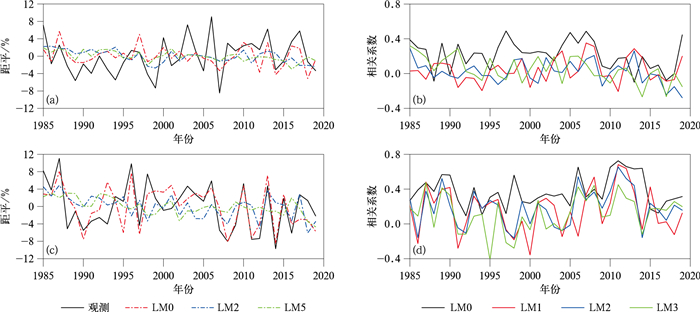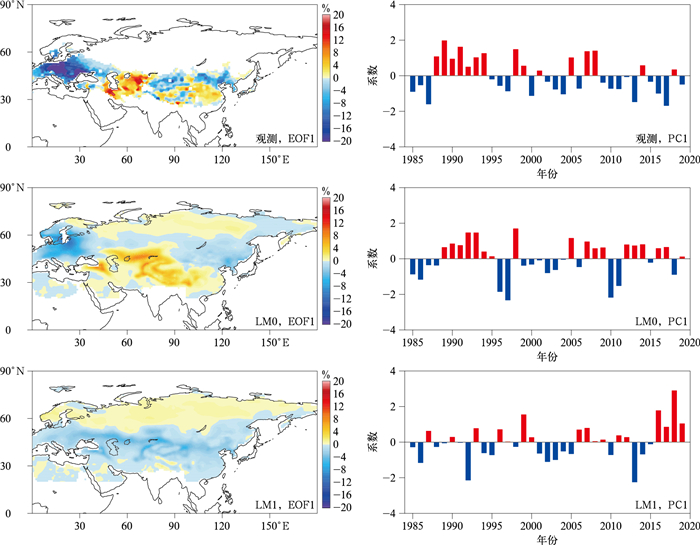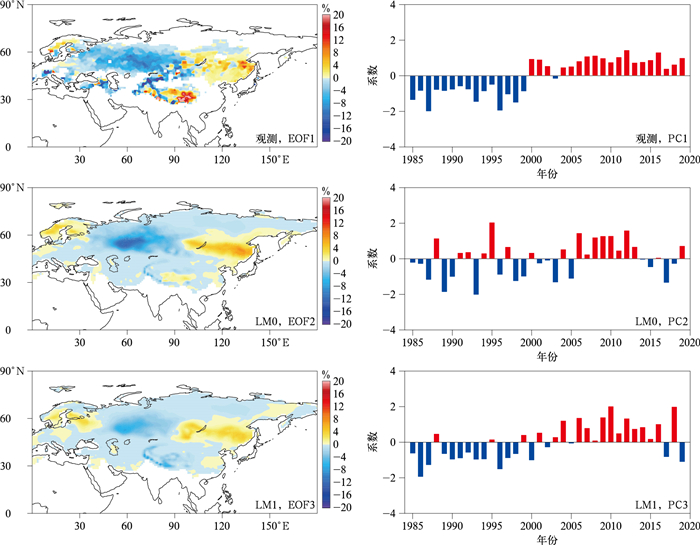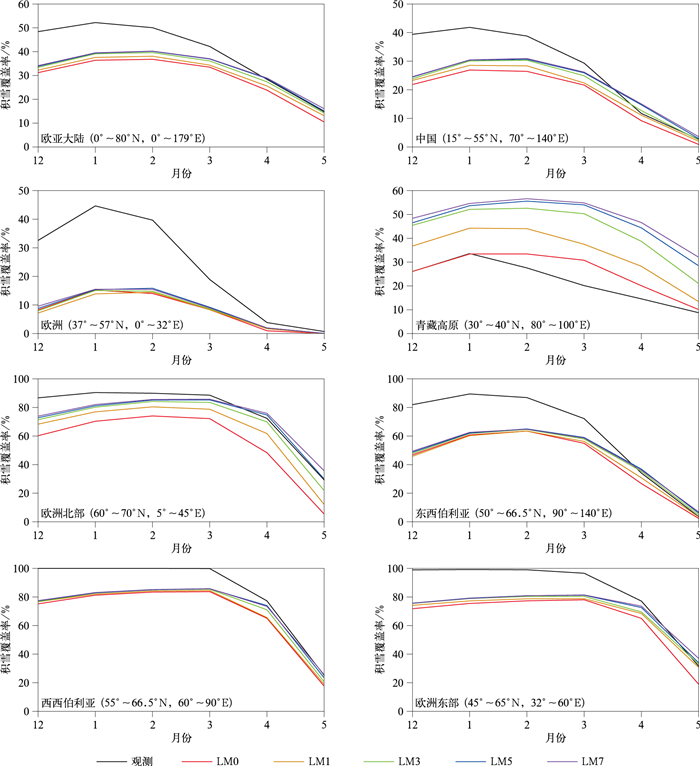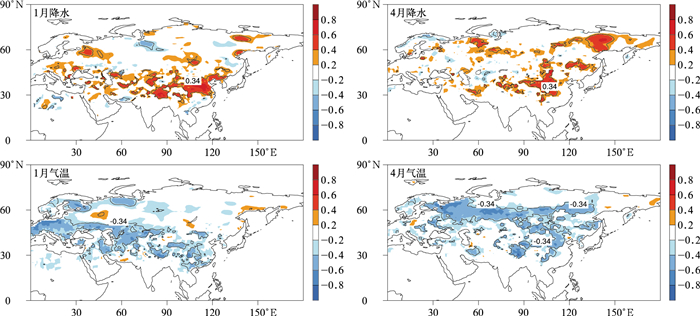Evaluation of Eurasian Snow Cover Fraction Prediction Based on BCC-CSM1.1m
-
摘要: 利用基于BCC-CSM1.1m模式建立的第2代季节预测模式系统1984—2019年历史回算数据,客观评估该模式对1月和4月欧亚积雪覆盖率(snow cover fraction,SCF)气候态和年际变化的预测技巧,分析模式预测偏差产生的可能原因。结果表明:BCC-CSM1.1m模式在超前0~2个月对欧亚大陆SCF具有一定预测技巧,对4月SCF的预测能力明显高于1月,1月预测技巧在欧洲西部地区最高,4月在西西伯利亚地区最高。SCF的预测结果在除青藏高原外的大范围地区表现为系统性偏低,预测偏差在1月随着起报时间的增长没有明显变化,而在4月随着起报时间的增长,关键区偏差由负转正并逐渐增大。分析表明,SCF预测偏差与模式中近地面气温的预测偏差有直接关系。除此之外,SCF的预测偏差部分源于模式本身的系统性偏差,模式分辨率以及参数化方案可能是预测结果在积雪覆盖率接近100%的高纬度地区明显偏低的原因。
-
关键词:
- 积雪覆盖率;
- BCC-CSM1.1m;
- 预测技巧;
- 评估
Abstract: The model ability to predict Eurasian snow cover fraction (SCF) is evaluated by using the hindcast data during 1984-2019 from the Beijing Climate Center (BCC) Climate Prediction System version 2 (CPSv2), developed based on Climate System Model BCC-CSM1.1m. The SCF reanalysis data from National Snow and Ice Data Center (NSIDC) and other common variables reanalysis datasets are also used against the model forecasts. The prediction skills of Eurasian SCF in January and April are investigated, which separately represent the snow cover situation of winter and spring. The possible causes of model prediction errors are also discussed partly using the simulation data of two BCC climate models, BCC-CSM1.1m and BCC-CSM2-MR, respectively participating the phase 5 of Coupled Model Intercomparison Project (CMIP5) and phase 6 (CMIP6). Empirical orthogonal function (EOF), spatial and temporal correlation analysis, statistical test and other common methods are also adopted. The results show that, BCC-CSM1.1m is capable of forecasting the SCF in Eurasia two months ahead. However, the prediction skill varies both in space and time. In comparison with January, the model shows a better prediction skill both in climatology and interannual variability of Eurasian SCF in April. The prediction skill is highest in western Europe in January and in western Siberia in April. Lower-than-observed SCF are found in most areas of Eurasia except Tibetan Plateau in the predictions for LM0 (0 lead month). This coherent negative biases hardly varies with longer lead time in January, while the biases in key area of April reverse to positive and gradually increase. Analysis indicates that the SCF biases in January and April are positively related with those of precipitation and negatively related with those of surface temperature in the model. Moreover, since the corelated region between the precipitation biases and SCF biases reduces to some small areas in contrast with the surface temperature, the biases of SCF in the model exhibit closer relationship with surface temperature biases. In addition, comparing simulations from two BCC models, it's also found that the systematic biases originated from model resolution, parameterization scheme, etc. are also fundamental factors, which can explain the obvious underestimation of SCF in high latitude where observed SCF is nearly 100%.-
Key words:
- snow cover fraction(SCF);
- BCC-CSM1.1m;
- prediction skill;
- evaluation
-
图 1 1月SCF的观测与预测
(图中黑色虚线框是定义的冬季关键区)
(a)观测的气候平均值, (b)观测的标准差, (c)LM0的预测偏差, (d)LM0的标准差, (e)LM2的预测偏差, (f)LM2的标准差Fig. 1 Observation and prediction of SCF in Jan
(the black dashed rectangles represent winter key area(WKA))
(a)mean SCF for observation, (b)standard deviation for observation, (c)climatological biases for LM0, (d)standard deviation for LM0, (e)climatological biases for LM2, (f)standard deviation for LM2图 3 SCF的TCC预测技巧空间分布
(黑色打点区域表示相关系数达到0.05显著性水平)
(a)LM0预测1月, (b)LM0预测4月, (c)LM1预测1月, (d)LM1预测4月, (e)LM2预测1月, (f)LM2预测4月Fig. 3 Spatial distribution of temporal correlations between predictions and observation for SCF
(the black grids denote the areas exceeding 0.05 level(Student's t-test))
(a)prediction for LM0 in Jan, (b)prediction for LM0 in Apr, (c)prediction for LM1 in Jan, (d)prediction for LM1 in Apr, (e)prediction for LM2 in Jan, (f)prediction for LM2 in Apr图 10 模式模拟的SCF偏差分布
(模拟值与观测值之差)(黑色虚线框分别表示冬季关键区和春季关键区)
(a)BCC-CSM1.1m模拟的1月,(b)BCC-CSM1.1m模拟的4月,(c)BCC-CSM2-MR模拟的1月,(d)BCC-CSM2-MR模拟的4月Fig. 10 Spatial distribution of simulated climatology biases of SCF
(simulation minus observation)(black dashed rectangles in Fig. 10a and Fig. 10c represent WKA while those in Fig. 10b and Fig. 10d represent SKA)
(a)Jan using BCC-CSM1.1m, (b)Apr using BCC-CSM1.1m, (c)Jan using BCC-CSM2-MR, (d)Apr using BCC-CSM2-MR -
[1] Blanford H F.On the connexion of the Himalaya snowfall with dry winds and seasons of drought in India. Proc Roy Soc London, 1884, 37:3-22. doi: 10.1098/rspl.1884.0003 [2] Cohen J. Snow cover and climate. Weather, 1994, 49(5): 150-156. doi: 10.1002/j.1477-8696.1994.tb05997.x [3] Essery R. Seasonal snow cover and climate change in the Hadley Centre GCM. Ann Glaciol, 1997, 25: 362-366. doi: 10.3189/S0260305500014282 [4] Cohen J, Rind D. The effect of snow cover on the climate. J Climate, 1991, 4(7): 689-706. doi: 10.1175/1520-0442(1991)004<0689:TEOSCO>2.0.CO;2 [5] Xia K, Wang B, Li L, et al. Evaluation of snow depth and snow cover fraction simulated by two versions of the flexible global ocean-atmosphere-land system model. Adv Atmos Sci, 2014, 31(2): 407-420. doi: 10.1007/s00376-013-3026-y [6] 鲁萌萌, 吴仁广, 杨崧, 等. 欧亚大陆冷季积雪与亚洲夏季风的关系: 区域特征与季节性. 大气科学学报, 2020, 43(1): 93-103. https://www.cnki.com.cn/Article/CJFDTOTAL-NJQX202001010.htmLu M M, Wu R G, Yang S, et al. Relationship between Eurasian cold-season snows and Asian summer monsoons: Regional characteristics and seasonality. Trans Atmos Sci, 2020, 43(1): 93-103. https://www.cnki.com.cn/Article/CJFDTOTAL-NJQX202001010.htm [7] 张人禾, 张若楠, 左志燕. 中国冬季积雪特征及欧亚大陆积雪对中国气候影响. 应用气象学报, 2016, 27(5): 513-526. doi: 10.11898/1001-7313.20160501Zhang R H, Zhang R N, Zuo Z Y. An overview of wintertime snow cover characteristics over China and the impact of Eurasian snow cover on Chinese climate. J Appl Meteor Sci, 2016, 27(5): 513-526. doi: 10.11898/1001-7313.20160501 [8] 李维京, 张若楠, 孙丞虎, 等. 中国南方旱涝年际年代际变化及成因研究进展. 应用气象学报, 2016, 27(5): 577-591. doi: 10.11898/1001-7313.20160507Li W J, Zhang R N, Sun C H, et al. Recent research advances on the interannual-interdecadal variations of drought/flood in South China and associated causes. J Appl Meteor Sci, 2016, 27(5): 577-591. doi: 10.11898/1001-7313.20160507 [9] Zuo Z, Zhang R, Wu B, et al. Decadal variability in springtime snow over Eurasia: Relation with circulation and possible influence on springtime rainfall over China. Int J Climatol, 2012, 32(9): 1336-1345. doi: 10.1002/joc.2355 [10] 唐佳, 武炳义. 20世纪90年代初东亚夏季风的年代际转型. 应用气象学报, 2012, 23(4): 402-413. doi: 10.3969/j.issn.1001-7313.2012.04.003Tang J, Wu B Y. Inter-decadal shift of East Asian summer monsoon in the early 1990s. J Appl Meteor Sci, 2012, 23(4): 402-413. doi: 10.3969/j.issn.1001-7313.2012.04.003 [11] 张人禾, 武炳义, 赵平, 等. 中国东部夏季气候20世纪80年代后期的年代际转型及其可能成因. 气象学报, 2008, 66(5): 698-706. https://www.cnki.com.cn/Article/CJFDTOTAL-QXXB200805004.htmZhang R H, Wu B Y, Zhao P, et al. The decadal shift of the summer climate in eastern China in late 1980s and its possible causes. Acta Meteor Sinica, 2008, 66(5): 698-706. https://www.cnki.com.cn/Article/CJFDTOTAL-QXXB200805004.htm [12] Wu B, Yang K, Zhang R. Eurasian snow cover variability and its association with summer rainfall in China. Adv Atmos Sci, 2009, 26(1): 31-44. doi: 10.1007/s00376-009-0031-2 [13] 丁一汇, 李怡, 王遵娅, 等. 亚非夏季风的年代际变化大西洋多年代际振荡与太平洋年代际振荡的协同作用. 大气科学学报, 2020, 43(1): 20-32. https://www.cnki.com.cn/Article/CJFDTOTAL-NJQX202001005.htmDing Y H, Li Y, Wang Z Y, et al. Interdecadal variation of Afro-Asian summer monsoon: Coordinated effects of AMO and PDO oceanic modes. Trans Atmos Sci, 2020, 43(1): 20-32. https://www.cnki.com.cn/Article/CJFDTOTAL-NJQX202001005.htm [14] 陈海山, 孙照勃. 欧亚积雪异常分布对冬季大气环流的影响Ⅰ. 观测研究. 大气科学, 2003, 27(3): 304-316. doi: 10.3878/j.issn.1006-9895.2003.03.02Chen H S, Sun Z B. The effects of Eurasian snow cover anomaly on winter atmospheric general circulation Part Ⅰ. Observational studies. Chinese Journal of Atmospheric Sciences, 2003, 27(3): 304-316. doi: 10.3878/j.issn.1006-9895.2003.03.02 [15] 陈兴芳, 宋文玲. 欧亚和青藏高原冬春季积雪与我国夏季降水关系的分析和预测应用. 高原气象, 2000, 19(2): 216-223. https://www.cnki.com.cn/Article/CJFDTOTAL-GYQX200002010.htmChen X F, Song W L. Analysis of relationship between snow cover on Eurasia and Tibetan Plateau in winter and summer rainfall in China and application to prediction. Plateau Meteorology, 2000, 19(2): 216-223. https://www.cnki.com.cn/Article/CJFDTOTAL-GYQX200002010.htm [16] 陈兴芳, 宋文玲. 冬季高原积雪和欧亚积雪对我国夏季旱涝不同影响关系的环流特征分析. 大气科学, 2000, 24(5): 586-592. https://www.cnki.com.cn/Article/CJFDTOTAL-DQXK200005001.htmChen X F, Song W L. Circulation analysis of different influence of snow cover over the Tibetan Plateau and Eurasia in winter on summertime droughts and floods of China. Chinese Journal of Atmospheric Sciences, 2000, 24(5): 586-592. https://www.cnki.com.cn/Article/CJFDTOTAL-DQXK200005001.htm [17] Wu R, Kirtman B P. Observed relationship of spring and summer East Asian rainfall with winter and spring Eurasian snow. J Climate, 2007, 20(7): 1285-1304. doi: 10.1175/JCLI4068.1 [18] 叶笃正. 长期预报的一些物理因子. 气象, 1975, 1(3): 10-12. https://www.cnki.com.cn/Article/CJFDTOTAL-QXXX197503005.htmYe D Z. Some physical factors of long-term forecast. Meteorological Monthly, 1975, 1(3): 10-12. https://www.cnki.com.cn/Article/CJFDTOTAL-QXXX197503005.htm [19] 李栋梁, 王春学. 积雪分布及其对中国气候影响的研究进展. 大气科学学报, 2011, 34(5): 627-636. doi: 10.3969/j.issn.1674-7097.2011.05.014Li D L, Wang C X. Research progress of snow cover and its influence on China climate. Trans Atmos Sci, 2011, 34(5): 627-636. doi: 10.3969/j.issn.1674-7097.2011.05.014 [20] 祝从文, 刘伯奇, 左志燕, 等. 东亚夏季风次季节变化研究进展. 应用气象学报, 2019, 30(4): 401-415. doi: 10.11898/1001-7313.20190402Zhu C W, Liu B Q, Zuo Z Y, et al. Recent advances on sub-seasonal variability of East Asian summer monsoon. J Appl Meteor Sci, 2019, 30(4): 401-415. doi: 10.11898/1001-7313.20190402 [21] 陈丽娟, 赵俊虎, 顾薇, 等. 汛期我国主要雨季进程成因及预测应用进展. 应用气象学报, 2019, 30(4): 385-400. doi: 10.11898/1001-7313.20190401Chen L J, Zhao J H, Gu W, et al. Advances of research and application on major rainy seasons in China. J Appl Meteor Sci, 2019, 30(4): 385-400. doi: 10.11898/1001-7313.20190401 [22] Peings Y, Douville H. Influence of the Eurasian snow cover on the Indian summer monsoon variability in observed climatologies and CMIP3 simulations. Climate Dyn, 2010, 34(5): 643-660. doi: 10.1007/s00382-009-0565-0 [23] Saha S K, Pokhrel S, Chaudhari H S. Influence of Eurasian snow on Indian summer monsoon in NCEP CFSv2 freerun. Climate Dyn, 2013, 41(7/8): 1801-1815. doi: 10.1007/s00382-012-1617-4 [24] Furtado J C, Cohen J L, Butler A H, et al. Eurasian snow cover variability and links to winter climate in the CMIP5 models. Climate Dyn, 2015, 45(9/10): 2591-2605. doi: 10.1007/s00382-015-2494-4 [25] Barnett T P, Dümenil L, Schlese U, et al. The effect of Eurasian snow cover on regional and global climate variations. J Atmos Sci, 1989, 46(5): 661-686. doi: 10.1175/1520-0469(1989)046<0661:TEOESC>2.0.CO;2 [26] 吴统文, 宋连春, 李伟平, 等. 北京气候中心气候系统模式研发进展——在气候变化研究中的应用. 气象学报, 2014, 72(1): 13-29. https://www.cnki.com.cn/Article/CJFDTOTAL-QXXB201401002.htmWu T W, Song L C, Li W P, et al. An overview on progress in Beijing climate center climate system model-Its development and application to climate change studies. Acta Meteor Sinica, 2014, 72(1): 13-29. https://www.cnki.com.cn/Article/CJFDTOTAL-QXXB201401002.htm [27] Liu X, Wu T, Yang S, et al. Performance of the seasonal forecasting of the Asian summer monsoon by BCC_CSM1.1(m). Adv Atmos Sci, 2015, 32(8): 1156-1172. doi: 10.1007/s00376-015-4194-8 [28] 周鑫, 李清泉, 孙秀博, 等. BCC_CSM1.1模式对我国气温的模拟和预估. 应用气象学报, 2014, 25(1): 95-106. https://www.cnki.com.cn/Article/CJFDTOTAL-YYQX201401011.htmZhou X, Li Q Q, Sun X B, et al. Simulation and projection of temperature in China with BCC_CSM1.1 model. J Appl Meteor Sci, 2014, 25(1): 95-106. https://www.cnki.com.cn/Article/CJFDTOTAL-YYQX201401011.htm [29] 唐慧琴, 曾刚, 黄悦. BCC_CSM1.1(m)模式对热带太平洋潜热通量的评估. 应用气象学报, 2016, 27(4): 463-472. doi: 10.11898/1001-7313.20160409Tang H Q, Zeng G, Huang Y. An assessment of the tropical pacific latent heat flux simulated by BCC_CSM 1.1(m). J Appl Meteor Sci, 2016, 27(4): 463-472. doi: 10.11898/1001-7313.20160409 [30] 吴统文, 宋连春, 刘向文, 等. 国家气候中心短期气候预测模式系统业务化进展. 应用气象学报, 2013, 24(5): 533-543. doi: 10.3969/j.issn.1001-7313.2013.05.003Wu T W, Song L C, Liu X W, et al. Progress in developing the short-range operational climate prediction system of China national climate center. J Appl Meteor Sci, 2013, 24(5): 533-543. doi: 10.3969/j.issn.1001-7313.2013.05.003 [31] 吴捷, 任宏利, 张帅, 等. BCC二代气候系统模式的季节预测评估和可预报性分析. 大气科学, 2017, 41(6): 1300-1315. https://www.cnki.com.cn/Article/CJFDTOTAL-DQXK201706013.htmWu J, Ren H L, Zhang S, et al. Evaluation and predictability analysis of seasonal prediction by BCC second-generation climate system model. Chinese Journal of Atmospheric Sciences, 2017, 41(6): 1300-1315. https://www.cnki.com.cn/Article/CJFDTOTAL-DQXK201706013.htm [32] 张丹琦, 孙凤华, 张耀存. 基于BCC第二代短期气候预测模式系统的中国夏季降水季节预测评估. 高原气象, 2019, 38(6): 1229-1240. https://www.cnki.com.cn/Article/CJFDTOTAL-GYQX201906010.htmZhang D Q, Sun F H, Zhang Y C. Evaluation of seasonal prediction for summer rainfall in China based on BCC second-generation short-range climate forecast systerm. Plateau Meteorology, 2019, 38(6): 1229-1240. https://www.cnki.com.cn/Article/CJFDTOTAL-GYQX201906010.htm [33] He Q, Zuo Z, Zhang R, et al. Prediction skill and predictability of Eurasian snow cover fraction in the NCEP climate forecast system version 2 reforecasts. Int J Climatol, 2016, 36(12): 4071-4084. doi: 10.1002/joc.4618 [34] 宋敏红, 吴统文, 张宇, 等. 近30年BCC-CSM(m)模拟高原积雪状况评估及其对夏季降水的影响. 高原气象, 2020, 39(1): 15-23. https://www.cnki.com.cn/Article/CJFDTOTAL-GYQX202001002.htmSong M H, Wu T W, Zhang Y, et al. Evaluation on simulated snow depth over Qinghai-Tibetan Plateau with BCC-CSM(m) model during recent 30 years and its impact on precipitation in summer. Plateau Meteorology, 2020, 39(1): 15-23. https://www.cnki.com.cn/Article/CJFDTOTAL-GYQX202001002.htm [35] 汪芋君, 任宏利, 王琳. 第三极地区气温和积雪的季节-年际气候预测研究. 地球科学进展, 2021, 36(2): 198-210. https://www.cnki.com.cn/Article/CJFDTOTAL-DXJZ202102008.htmWang Y J, Ren H L, Wang L. Study of seasonal-interannual climate predictions of temperature and snow depth over the third pole. Adv Earth Sci, 2021, 36(2): 198-210. https://www.cnki.com.cn/Article/CJFDTOTAL-DXJZ202102008.htm [36] Bamzai A S, Shukla J. Relation between Eurasian snow cover, snow depth, and the Indian summer monsoon: An observational study. J Climate, 1999, 12(10): 3117-3132. doi: 10.1175/1520-0442(1999)012<3117:RBESCS>2.0.CO;2 [37] 郭渠, 刘向文, 吴统文, 等. 基于BCC_CSM模式的中国东部夏季降水预测检验及订正. 大气科学, 2017, 41(1): 71-90. https://www.cnki.com.cn/Article/CJFDTOTAL-DQXK201701006.htmGuo Q, Liu X W, Wu T W, et al. Verification and correction of East China summer rainfall prediction based on BCC_CSM. Chinese Journal of Atmospheric Sciences, 2017, 41(1): 71-90. https://www.cnki.com.cn/Article/CJFDTOTAL-DQXK201701006.htm [38] Wu T, Lu Y, Fang Y, et al. The Beijing climate center climate system model (BCC-CSM): The main progress from CMIP5 to CMIP6. Geosci Model Dev, 2019, 12(4): 1573-1600. doi: 10.5194/gmd-12-1573-2019 [39] 李演达, 吴统文, 刘向文, 等. 初值对中国东部初夏土壤湿度可预报性影响. 应用气象学报, 2018, 29(4): 423-435. doi: 10.11898/1001-7313.20180404Li Y D, Wu T W, Liu X W, et al. The impact of initial conditions on soil moisture predictability in early summer in Eastern China. J Appl Meteor Sci, 2018, 29(4): 423-435. doi: 10.11898/1001-7313.20180404 -


 设为首页
设为首页 加入收藏
加入收藏



 下载:
下载:


